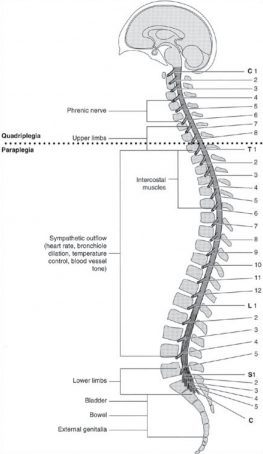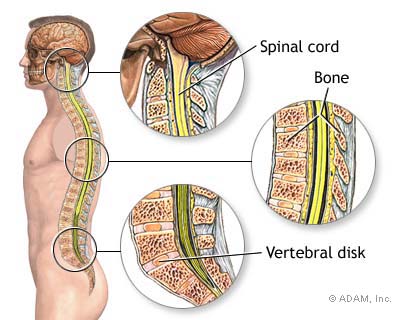Traumatic Paraplegia: Difference between revisions
Kim Jackson (talk | contribs) m (Removed RSS Feed box) |
mNo edit summary |
||
| Line 7: | Line 7: | ||
Traumatic paraplegia is caused by a lesion of the spinal cord which occurs after a trauma, e.g. vertebral fracture causing a puncture to the spinal cord. | Traumatic paraplegia is caused by a lesion of the spinal cord which occurs after a trauma, e.g. vertebral fracture causing a puncture to the spinal cord. | ||
Traumatic paraplegia can lead to paralyzed parts of the lower extremity, spasms of the lower limbs, bladder dysfunction, all under the place of the damaged part of the spine. The problem would be with the cord which dysfunctions, leading to potentials through the limbs which may then lead to the symptoms of this pathology. <ref name="Hardy et al.">PATHOLOGICAL OSSIFICATION IN TRAUMATIC PARAPLEGIA*; A. G. HARDY, SHEFFIELD, and J. W. DICKSON, IPSWICH, ENGLAND ; 1963</ref><ref name="Guttman et al.">Initial Treatment of Traumatic Paraplegia; By L. GUTTMANN, O.B.E., M.D., M.R.C.P.;1953</ref><ref name="Sedgwick et al.">Spinal cord potentials in traumatic paraplegia and quadriplegia; E M SEDGWICK, E EL-NEGAMY, AND H FRANKEL; 1980</ref> | Traumatic paraplegia can lead to paralyzed parts of the lower extremity, spasms of the lower limbs, bladder dysfunction, all under the place of the damaged part of the spine. The problem would be with the cord which dysfunctions, leading to potentials through the limbs which may then lead to the symptoms of this pathology. <ref name="Hardy et al.">PATHOLOGICAL OSSIFICATION IN TRAUMATIC PARAPLEGIA*; A. G. HARDY, SHEFFIELD, and J. W. DICKSON, IPSWICH, ENGLAND ; 1963</ref><ref name="Guttman et al.">Initial Treatment of Traumatic Paraplegia; By L. GUTTMANN, O.B.E., M.D., M.R.C.P.;1953</ref><ref name="Sedgwick et al.">Spinal cord potentials in traumatic paraplegia and quadriplegia; E M SEDGWICK, E EL-NEGAMY, AND H FRANKEL; 1980</ref> | ||
| Line 29: | Line 27: | ||
This injury has a major effect on the social life of the patient, such as divorce or loss of work. Therefore, it might be important as a physiotherapist to talk with the patient about considering professional psychological help and assist in guiding him/her through this process. | This injury has a major effect on the social life of the patient, such as divorce or loss of work. Therefore, it might be important as a physiotherapist to talk with the patient about considering professional psychological help and assist in guiding him/her through this process. | ||
== Physical Therapy Management == | == Physical Therapy Management == | ||
| Line 39: | Line 34: | ||
*the control of urinary infections (this is mainly the task of the doctors) | *the control of urinary infections (this is mainly the task of the doctors) | ||
*the prevention of muscle tendon contractures of paralyzed limbs due to faulty position (e.g. keeping the legs constantly adducted, the hips and knees flexed, and the feet and toes in plantar flexion) | *the prevention of muscle tendon contractures of paralyzed limbs due to faulty position (e.g. keeping the legs constantly adducted, the hips and knees flexed, and the feet and toes in plantar flexion) | ||
**faulty positions can be prevented by physiotherapy treatment such as strengthening and stretching of the muscles of the trunk and upper limbs<ref name="Guttmann et al.">SURGICAL ASPECTS OF THE TREATMENT OF TRAUMATIC PARAPLEGIA; Guttmann; 1949</ref><ref name="Hedera et al."/> | **faulty positions can be prevented by physiotherapy treatment such as strengthening and stretching of the muscles of the trunk and upper limbs<ref name="Guttmann et al.">SURGICAL ASPECTS OF THE TREATMENT OF TRAUMATIC PARAPLEGIA; Guttmann; 1949</ref><ref name="Hedera et al." /> | ||
Like every injury complete immobilization should be prevented. It has been shown that an intensive physical training program of 10 to 15 weeks could make the patient climb and go down 20 standard stairs and be able to walk 100 meters indoors with crutches for example. It is highly recommended not to be independent of a wheel-chair and try to be mobile as much as possible.<ref name="Natvig et al.">Ambulation without wheelchairs for paraplegics with complete lesions.; Natvig H, McAdam R.; 1978</ref> Intense and regular therapy for spasticity, including physiotherapy, can delay and minimize the appearance of these complications named above.<ref name="Hedera et al.">Spastic Paraplegia 3A , SPG3A; Peter Hedera ; 2010</ref> | Like every injury complete immobilization should be prevented. It has been shown that an intensive physical training program of 10 to 15 weeks could make the patient climb and go down 20 standard stairs and be able to walk 100 meters indoors with crutches for example. It is highly recommended not to be independent of a wheel-chair and try to be mobile as much as possible.<ref name="Natvig et al.">Ambulation without wheelchairs for paraplegics with complete lesions.; Natvig H, McAdam R.; 1978</ref> Intense and regular therapy for spasticity, including physiotherapy, can delay and minimize the appearance of these complications named above.<ref name="Hedera et al.">Spastic Paraplegia 3A , SPG3A; Peter Hedera ; 2010</ref> | ||
== General Lower Limb Neuological Examination == | == General Lower Limb Neuological Examination == | ||
Revision as of 18:55, 17 June 2019
Original Editor - Wouter Claesen
Top Contributors - Wouter Claesen, Vanessa Rhule, Blessed Denzel Vhudzijena, Evan Thomas, Naomi O'Reilly, Lucinda hampton, 127.0.0.1, Admin, Wendy Walker, WikiSysop and Kim Jackson
Definition/Description[edit | edit source]
Traumatic paraplegia is caused by a lesion of the spinal cord which occurs after a trauma, e.g. vertebral fracture causing a puncture to the spinal cord.
Traumatic paraplegia can lead to paralyzed parts of the lower extremity, spasms of the lower limbs, bladder dysfunction, all under the place of the damaged part of the spine. The problem would be with the cord which dysfunctions, leading to potentials through the limbs which may then lead to the symptoms of this pathology. [1][2][3]
Clinical Relevant Anatomy[edit | edit source]
The spinal cord is connected to the brain, where it descends down the middle of the back, surrounded and protected by the bony vertebral column. The spinal cord is surrounded by Cerebral Spinal Fluid (CSF). Its function is to prevent the delicate nerve tissue from the inside of the vertebrae. The spinal cord itself consists of millions of nerve fibers which transmit electrical information to and from the limbs, trunk and organs of the body, to and from the brain. The Central Nervous System (CNS) consists of the brain and spinal cord. The nerves connecting the spinal cord to the body is called the Peripheral Nervous System (PNS).
Epidemiology/Etiology[edit | edit source]
The cause of paraplegia due to a spinal cord injury is most often by a car accident. It can also result from a firearm injury, which is not the case in many countries in the world. Traumatic paraplegia is most prominent in young men between the ages of 21 and 35 years. The more reckless way of driving within the younger population could also be one of the reasons.
This injury has a major effect on the social life of the patient, such as divorce or loss of work. Therefore, it might be important as a physiotherapist to talk with the patient about considering professional psychological help and assist in guiding him/her through this process.
Physical Therapy Management[edit | edit source]
From the very beginning, all efforts should be concentrated on the rehabilitation of the patient. The most important points which need to be considered in the early stages or even immediate stages are:
- the prevention of pressure sores
- the control of urinary infections (this is mainly the task of the doctors)
- the prevention of muscle tendon contractures of paralyzed limbs due to faulty position (e.g. keeping the legs constantly adducted, the hips and knees flexed, and the feet and toes in plantar flexion)
Like every injury complete immobilization should be prevented. It has been shown that an intensive physical training program of 10 to 15 weeks could make the patient climb and go down 20 standard stairs and be able to walk 100 meters indoors with crutches for example. It is highly recommended not to be independent of a wheel-chair and try to be mobile as much as possible.[6] Intense and regular therapy for spasticity, including physiotherapy, can delay and minimize the appearance of these complications named above.[5]
General Lower Limb Neuological Examination[edit | edit source]
References[edit | edit source]
- ↑ PATHOLOGICAL OSSIFICATION IN TRAUMATIC PARAPLEGIA*; A. G. HARDY, SHEFFIELD, and J. W. DICKSON, IPSWICH, ENGLAND ; 1963
- ↑ Initial Treatment of Traumatic Paraplegia; By L. GUTTMANN, O.B.E., M.D., M.R.C.P.;1953
- ↑ Spinal cord potentials in traumatic paraplegia and quadriplegia; E M SEDGWICK, E EL-NEGAMY, AND H FRANKEL; 1980
- ↑ SURGICAL ASPECTS OF THE TREATMENT OF TRAUMATIC PARAPLEGIA; Guttmann; 1949
- ↑ 5.0 5.1 Spastic Paraplegia 3A , SPG3A; Peter Hedera ; 2010
- ↑ Ambulation without wheelchairs for paraplegics with complete lesions.; Natvig H, McAdam R.; 1978
- ↑ Bahaa Mostafa Kamel. https://www.youtube.com/watch?v=VG8Uzt87gko [last accessed 10/02/2016]








